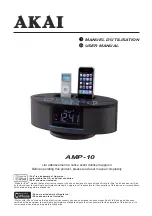
25
24
L206
ENG
User manual
BATTERY MAINTENANCE
Battery maintenance starts from the moment you receive a new battery and continues
throughout its lifetime. The main maintenance activities are indicated in the table below:
CAUTION:
If allowed to discharge completely, lithium ion batteries may suffer irreparable damage
that will drastically shorten their lifespan. Avoid fully discharging the battery during use
in order to maintain its durability and reliability over time.
PRECAUTIONS DURING USE
Lithium ion batteries are characterised by their compact dimensions and high energy
capacity. Take care when handling the battery pack; incorrect use could cause physical
injury and/or material damage.
Carefully observe the following safety instructions:
Do not short circuit the battery: make sure that the terminals do not come into contact
with metal or other conductive materials during transportation and storage.
Do not drop, crush or puncture the battery. Improper use may cause internal damage and
short-circuits that may not visible externally.
Do not install the battery with the polarity reversed.
Do not allow the battery to come into contact with liquids.
Do not burn the battery or expose it to temperatures greater than 60°C.
Do not attempt to open the battery pack or remove its internal cells.
If the battery is dropped or suffers an impact against a hard surface, regardless of its
external condition:
Stop using it immediately.
Dispose of the battery in conformance with the applicable regulations.
BATTERY LIFESPAN
The lifespan of a lithium ion battery depends on the frequency and duration of its use.
If used correctly, the internal cells will have a service life of approximately 500 charge/
discharge cycles, or typically 3 years, depending on the daily usage. The risk of faults
developing increases with time and depends on the conditions of use; faults may cause
the battery to overheat, and in rare cases, combustion or explosion.
DISPOSAL
Discharge the battery and cover the terminals with insulating tape before disposal. Dispose
of used or faulty batteries promptly and in accordance with the applicable recycling
regulations.
ACTIVITY
DESCRIPTION
Carry out a visual inspection
Before inserting the battery in the unit.
Check the polarity of the terminals: red positive (+), black
negative (-). Check the battery is not deformed, dented or
punctured.
Charge the battery
On receiving a new battery, after use or if the low battery
signal appears.
To optimise performance, the battery should be charged as
soon as possible when fully or nearly fully discharged.
The battery should be stored with a charge level of
between 20% and 40%
When it is not to be used for a extended period.














































